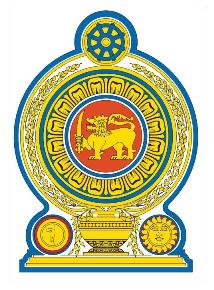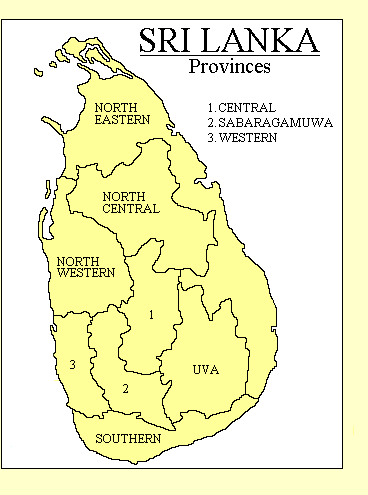

DEMOCRATIC SOCIALIST
REPUBLIC OF SRI LANKA
• Official name: Sri Lanka Prajatantrika Samajavadi Janarajaya / Llankai Jananayaka
Socialisak Kutiyarasu (Democratic Socialist Republic of Sri Lanka)
• Location: South Asia
• International organisations: Commonwealth of Nations, Non-Aligned Movement,
United Nations, World Trade Organisation
• Borders: None
• Coastline: Indian Ocean
• Land area: 65,610 Km2
• Population: 20,200,000
• Annual GDP (PPP) per capita: US$4,500 (2009 CIA estimate). World ranking: 120
• Ethnicity: Sinhalese 74%, Tamil 18%, Arab 7%. There are small minorities of
Europeans and part-Europeans (known as Burghers).
• Languages: Sinhala and Tamil are the official languages. Sinhala is spoken by about
75% of the population. Tamil is spoken by about 18%, and other languages by 8%.
• Religion: Buddhist 70%, Hindu 15%, Christian 8%, Moslem 7%
• Form of government: Parliamentary democratic republic. Sri Lanka is divided into eight provinces.
• Capital: Sri Jayewardenepura Kotte (a suburb of Colombo, which is the de facto
capital).
• Constitution: The
Constitution of Sri Lanka came into effect on
16 August 1978, but has been substantially amended since.
• Head of state: The President, elected by direct universal suffrage for a six-year term. The Constitution gives the
President substantial authority over the government.

• Head of government: The Prime Minister, appointed by the President. The Prime Minister is the leader of the largest
party in the legislature and is accountable to it.
• Legislature: Sri Lanka has a unicameral legislature. The
National Assembly has 225 members, elected for six-year terms.
Of these, 196 are elected from multi-member constituencies and 29 by proportional representation.
• Electoral authority: The Sri Lanka Department of Elections administers
national elections.
• Freedom House 2009 rating: Political Rights 4, Civil Liberties 4
Political history
The coastal areas of Ceylon (Lanka in Sinhala) were under Dutch control from the 17th century, although the Kingdom of
Kandy in the interior of the island remained independent. The British seized the island from the Dutch in 1796, and in 1802
it became a Crown Colony. Kandy was annexed in 1815. The British enouraged the growth of tea planting and the importation of
Tamils from southern India to work on the plantations.
A Ceylon National Congress was formed in 1919. In 1931 limited self-government was introduced, with a legislature
elected by universal suffrage. In 1945 the British, eager to depart, granted full internal self-government, and in 1947
Ceylon became independent.
The history of independent Celyon (officially known as Sri Lanka since 1972) has been dominated by the
issue of relations between the Sinhala majority and the Tamil minority. Ceylon's first Prime Minister,
Don Stephen Senanayake, favoured conciliation between the two groups, but in 1956 a Sinhala nationalist
government led by Solomon Bandaranaike came to power. Solomon's widow, Sirimavo, was twice Prime Minister, and his daughter
Chandrika Bandaranaike Kumaratunga was Prime Minister and then President.
The election of a conservative United National Party
government led by Junius Jayawardene in 1977 marked a breakdown in
communal relations which soon degenerated into civil war, with organisations such as the Tamil Tigers
waging a prolonged guerilla war and a campaign of terrorism against the government in Colombo and the
Sinhala majority. Over 80,000 people were killed, and in 1993 President Ranasinghe Premadasa was assassinated by a
Tamil Tiger suicide bomber.

In 1994 the Bandaranaikes returned to power at the head of a left-wing and nationalist coalition,
with Chandrika as President and Sirimavo as Prime Minister. Their
United People's Freedom Alliance government was dominated
by the left-wing Sri Lanka Freedom Party, allied with the Communist Party of Sri Lanka
and the semi-Trotskyist Sri Lanka Equal Society Party; once powerful parties now reduced to dependency on the
SLFP.
But the Bandaranaikes' hardline policy against the Tamils failed once more, and in 2000
the UNP returned to power on a policy of negotiation and reconciliation. The UNP government faced opposition from
President Kuamaratunga, who dismissed them in 2001, when the Alliance returned to power. In 2004 the Alliance won a majority
of seats at the legislative elections and Alliance candidate,
SLFP leader Mahinda Rajapakse, was elected President in 2005.
The SLFP's Ratnasiri Wickremanayake
has been Prime Minister since 2005, but Rajapakse runs the government. He finally succeeded in defeating the Tamil Tigers in 2009, but
his expected triumphant re-election was threatened when the military architect of victory, General Sarath Fonseka, ran against
him for the UNP at the 2010 presidential election. Rajapakse was re-elected with 54% of the vote.
Moderate Tamil nationalism is now represented by the Tamil National
Alliance (website offline). Extreme Sinhala nationalism is represented by the
People's United Liberation Front or JVP (originally a Maoist grouping). Both these
parties, for diametrically opposed reasons, supported Fonseka at the 2010 elections.
Freedom House's 2009
report on Sri Lanka
(which was written before the end of the civil war in 2009) says: "Sri Lanka is an electoral democracy. The 1978 constitution
vested strong executive powers in the president, who is directly elected for a six-year term and can dissolve Parliament.
Elections are open to multiple parties, and fair electoral laws and equal campaigning opportunities ensure a competitive
political process. While elections are generally free and fair, they continue to be marred by some irregularities, violence,
and intimidation... Official corruption is a continuing concern, and the current legal and administrative framework is
inadequate for promoting integrity and punishing corrupt behavior. Sri Lanka was ranked 92 out of 180 countries surveyed in
Transparency International's 2008 Corruption Perceptions Index... Media freedom declined further in 2008, as outlets faced
increased restrictions on covering the conflict and journalists encountered heightened attacks and intimidation, particularly
in the north... Freedom of assembly is typically upheld. Although the 2005 emergency regulations give the president the power
to restrict rallies and gatherings, permission for demonstrations is usually granted... Successive governments have respected
the constitutional provision for an independent judiciary, and judges can generally make decisions without overt intimidation
from the political branches. In recent years there has been growing concern about the politicisation of the judiciary."
Updated January 2010
|

